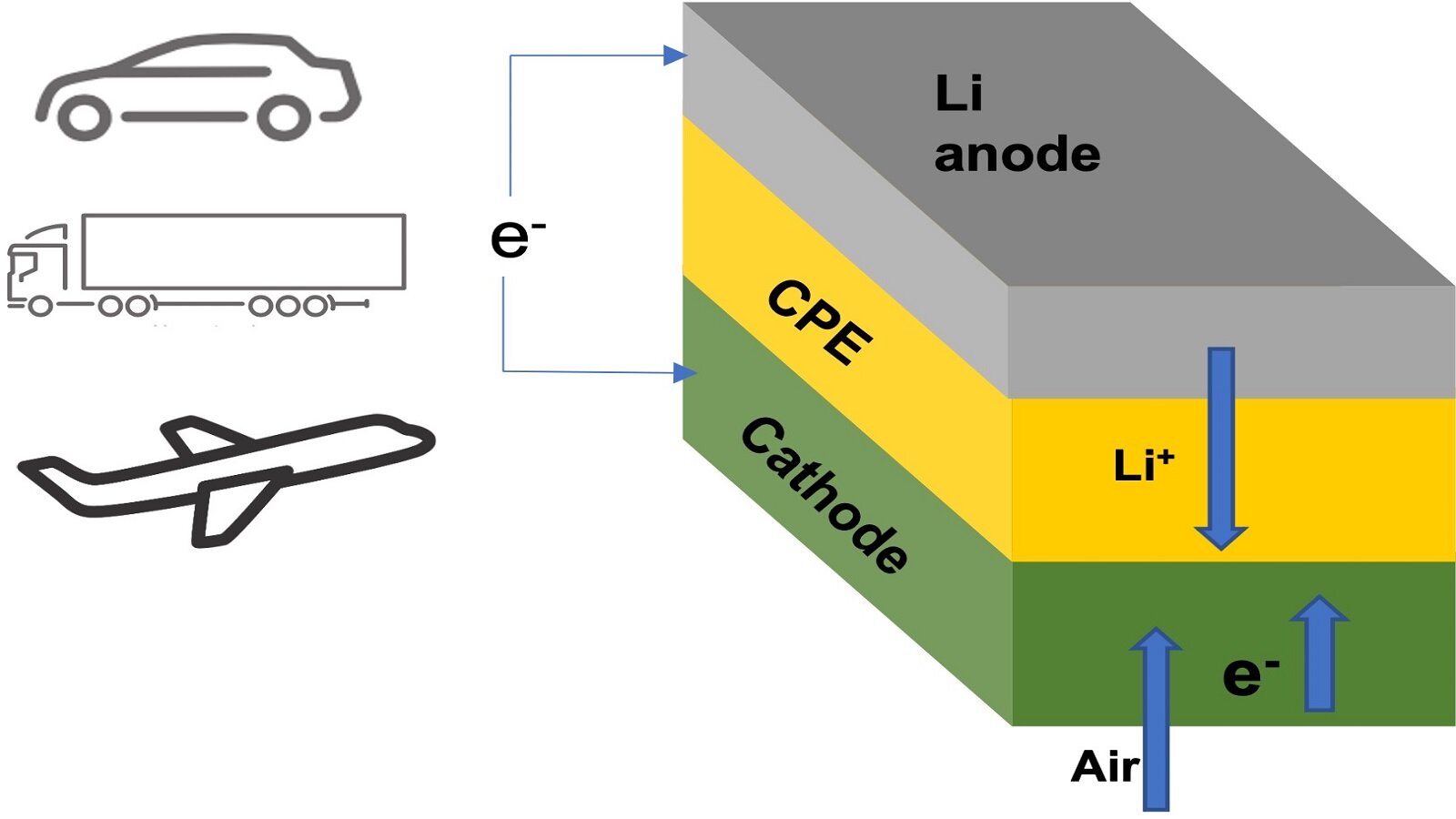博文
《科学》:与锂离子电池相比,新设计的锂空气电池可以提供更长的行驶里程
||
《科学》:与锂离子电池相比,新设计的锂空气电池可以提供更长的行驶里程
诸平
据美国阿贡国家实验室(Argonne National Laboratory)2023年2月23日提供的消息,该实验室的研究人员设计出新的锂空气电池(lithium-air battery)。与锂离子电池相比,新设计的锂空气电池可以提供更长的行驶里程(New design for lithium-air battery could offer much longer driving range compared with the lithium-ion battery)。
许多电动汽车的车主都希望有一种电池组,充电一次就能行驶1000多英里(1600多千米,1mile=1.609344 km)。美国伊利诺伊理工学院(Illinois Institute of Technology简称IIT, Chicago, IL USA)和美国能源部(DOE)阿尔贡国家实验室(Argonne National Lab, Lemont, IL, USA)的研究人员合作,开发出了一种可以让梦想成真的锂空气电池。该团队的新电池设计有朝一日还可以为国内飞机和长途卡车提供动力。相关研究结果于2023年2月2日已经在《科学》(Science)杂志网站发表——Alireza Kondori, Mohammadreza Esmaeilirad, Ahmad Mosen Harzandi, Rachid Amine, Mahmoud Tamadoni Saray, Lei Yu, Tongchao Liu, Jianguo Wen, Nannan Shan, Hsien-Hau Wang, Anh T. Ngo, Paul C. Redfern, Christopher S. Johnson, Khalil Amine, Reza Shahbazian-Yassar, Larry A. Curtiss, Mohammad Asadi. A room temperature rechargeable Li2O-based lithium-air battery enabled by a solid electrolyte. Science, 2 Feb 2023. 379(6631): 499-505. DOI: 10.1126/science.abq1347. https://www.science.org/doi/10.1126/science.abq1347
参与此项研究的除了来自伊利诺伊理工学院和美国DOE阿尔贡国家实验室的研究人员之外,还有来自伊利诺伊大学芝加哥分校(University of Illinois at Chicago, IL, USA)、美国斯坦福大学(Stanford University, CA, USA)、沙特阿拉伯的伊玛目·阿卜杜勒拉赫曼·本·费萨尔大学(Imam Abdulrahman Bin Faisal University简称IAU, Dammam, Saudi Arabia)的研究人员。
这种锂空气电池的主要新部件是固体电解质(solid electrolytes),而不是通常的液体电解质。固体电解质电池与锂离子电池和其他类型电池中使用的液体电解质相比不会出现安全问题,后者可能会过热并起火。更重要的是,该团队的电池化学性质与固体电解质结合,可以将能量密度(energy density)提高到锂离子电池(lithium-ion batteries)的4倍,从而延长行驶里程。
“十多年来,阿贡国家实验室和其他地方的科学家们一直在加班加点开发一种利用空气中氧气的锂电池,”阿贡国家实验室杰出研究员(Argonne Distinguished Fellow)拉里·柯蒂斯(Larry Curtiss)说。“锂空气电池的预计能量密度是除锂离子电池以外的下一代电池技术中最高的。”
在过去的锂-空气电池设计中,锂金属阳极中的锂在放电过程中通过液体电解质与氧气结合,在阴极生成过氧化锂(Li2O2)或超氧化锂(LiO2)。过氧化锂或超氧化锂在充电过程中分解为锂和氧成分。这个化学序列根据需要储存和释放能量。
该团队的新型固体电解质(new solid electrolyte)是由一种由相对廉价的纳米颗粒元素制成的陶瓷聚合物材料(ceramic polymer material)组成的。这种新型固体可以在放电时进行化学反应生成氧化锂(Li2O)。
超氧化物锂或过氧化物锂的化学反应只涉及每个氧分子中存储一两个电子,而氧化锂的化学反应则涉及四个电子,”阿贡国家实验室化学家拉希德·阿明(Rachid Amine)说。储存的电子越多,能量密度越高。
该团队的锂空气电池设计是第一个在室温下实现四电子反应的锂空气电池,它还利用周围环境的空气提供的氧气来运行。由于能够在空气中运行,因此无需使用另外备用的氧气罐,而这在早期的设计中是存在问题的。
研究小组采用了许多不同的技术来确定四电子反应是否确实发生了。一项关键技术是对阴极表面上的放电产物进行透射电子显微镜(transmission electron microscopy简称TEM)检测,这项技术是在美国能源部科学办公室用户设施阿贡纳米材料中心(Argonne's Center for Nanoscale Materials)进行的。TEM图像提供了对四电子放电机制有价值的见解。
过去的锂空气测试电池寿命极短。该团队通过构建并运行1000次循环的测试电池,证明了该电池在重复充电和放电下的稳定性,确定了新电池设计不存在这种缺陷。
“随着进一步的开发,我们希望我们的锂空气电池(lithium-air battery)新设计也能达到1200 Wh/kg的创纪录能量密度,这几乎是锂离子电池的四倍,”拉里·柯蒂斯说。
本研究得到了美国能源部(U.S. Department of Energy: DE-AC02-06CH11357)、美国国家科学基金会(NSF: DMR-1809439)以及旺格可持续能源研究所{ Wanger Institute for Sustainable Energy Research (WISER): 262029 221E 2300}的资助。
上述介绍,仅供参考。欲了解更多信息,敬请注意浏览原文或者相关报道。
An enabling composite electrolyte
Lithium-air batteries have scope to compete with gasoline in terms of energy density. However, in most systems, the reaction pathways either involve one- or two-electron transfer, leading to lithium peroxide (Li2O2) or lithium superoxide (LiO2), respectively. Kondori et al. investigated a lithium-air battery that uses a ceramic-polyethylene oxide–based composite solid electrolyte and found that it can undergo a four-electron redox reaction through lithium oxide (Li2O) formation and decomposition (see the Perspective by Dong and Lu). The composite electrolyte embedded with Li10GeP2S12 nanoparticles shows high ionic conductivity and stability and high cycle stability through a four-electron transfer process. —MSL
A lithium-air battery based on lithium oxide (Li2O) formation can theoretically deliver an energy density that is comparable to that of gasoline. Lithium oxide formation involves a four-electron reaction that is more difficult to achieve than the one- and two-electron reaction processes that result in lithium superoxide (LiO2) and lithium peroxide (Li2O2), respectively. By using a composite polymer electrolyte based on Li10GeP2S12 nanoparticles embedded in a modified polyethylene oxide polymer matrix, we found that Li2O is the main product in a room temperature solid-state lithium-air battery. The battery is rechargeable for 1000 cycles with a low polarization gap and can operate at high rates. The four-electron reaction is enabled by a mixed ion–electron-conducting discharge product and its interface with air.
https://blog.sciencenet.cn/blog-212210-1378118.html
上一篇:《自然能源》:新的研究密切关注能量储存
下一篇:《自然》:中美科学家利用电化学将二氧化碳转化为有用的分子
